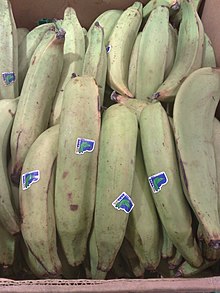
Back Kochbanane ALS موز الجنة Arabic موز الجنه ARZ Bişirmə banan Azerbaijani Плантан Bulgarian Plàtan de cuinar Catalan Plantain Czech Kochbanane German Μπανάνες Αντιλλών Greek Kuirbanano Esperanto
This article needs additional citations for verification. (August 2023) |
| Cooking bananas | |
|---|---|
 Large bunch of cooking bananas | |
| Genus | Musa |
| Species | Musa × paradisiaca |
| Hybrid parentage | M. acuminata × M. balbisiana |
| Cultivar group | Cultivars from a number of groups, including the AAA Group, the AAB Group and the ABB Group |
| Origin | Southeast Asia[1] |


Cooking bananas[2] are a group of starchy banana cultivars in the genus Musa whose fruits are generally used in cooking. They are not eaten raw and generally starchy.[1] Many cooking bananas are referred to as plantains (/ˈplæntɪn/, /plænˈteɪn/, /ˈplɑːntɪn/[3]) or 'green bananas'. In botanical usage, the term "plantain" is used only for true plantains, while other starchy cultivars used for cooking are called "cooking bananas". True plantains are cooking cultivars belonging to the AAB group, while cooking bananas are any cooking cultivar belonging to the AAB, AAA, ABB, or BBB groups. The currently accepted scientific name for all such cultivars in these groups is Musa × paradisiaca.[4] Fe'i bananas (Musa × troglodytarum) from the Pacific Islands are often eaten roasted or boiled, and are thus informally referred to as "mountain plantains", but they do not belong to any of the species from which all modern banana cultivars are descended.[5]
Cooking bananas are a major food staple in West and Central Africa, the Caribbean islands, Central America, and northern South America.[6] Members of the genus Musa are indigenous to the tropical regions of Southeast Asia and Oceania.[7] Bananas fruit all year round, making them a reliable all-season staple food.[8]
Cooking bananas are treated as a starchy fruit with a relatively neutral flavor and soft texture when cooked. Cooking bananas may be eaten raw; however, they are most commonly prepared either fried, boiled, or processed into flour or dough.[1]
- ^ a b c "Plantain | Description, Uses, History, & Facts". Encyclopedia Britannica. Retrieved 3 October 2021.
- ^ Smyth, Stuart J.; Phillips, Peter W. B.; Castle, David (28 March 2014). Handbook on Agriculture, Biotechnology and Development. Cheltenham, UK: Edward Elgar Publishing. p. 107. doi:10.4337/9780857938350. ISBN 978-0-85793-835-0.
{{cite book}}: CS1 maint: date and year (link) - ^ "plantain". Oxford English Dictionary (Online ed.). Oxford University Press. Retrieved 3 October 2021. (Subscription or participating institution membership required.)
- ^ Molina, A. B.; Roa, V. N. (2000). Advancing Banana and Plantain R and D in Asia and the Pacific. Bioversity International. pp. 55–60. ISBN 978-971-91751-3-1.
- ^ Ortiz, R.; Ferris, R. S. B.; Vuylsteke, D. R. (1995), Gowen, S. (ed.), "Banana and plantain breeding", Bananas and Plantains, Dordrecht: Springer Netherlands, pp. 110–146, doi:10.1007/978-94-011-0737-2_5, ISBN 978-94-011-0737-2, retrieved 12 March 2024
- ^ Otegbayo, B.; Lana, O.; Ibitoye, W. (December 2010). "Isolation and physicochemical characterization of starches isolated from plantain (Musa paradisiaca) and cooking banana (Musa sapientum)". Journal of Food Biochemistry. 34 (6): 1303–1318. doi:10.1111/j.1745-4514.2010.00354.x.
- ^ Roux, Nicolas; Baurens, Franc-Christophe; Doležel, Jaroslav; Hřibová, Eva; Heslop-Harrison, Pat; Town, Chris; Sasaki, Takuji; Matsumoto, Takashi; Aert, Rita (2008), Moore, Paul H.; Ming, Ray (eds.), "Genomics of Banana and Plantain (Musa spp.), Major Staple Crops in the Tropics", Genomics of Tropical Crop Plants, New York, NY: Springer, pp. 83–111, doi:10.1007/978-0-387-71219-2_4, ISBN 978-0-387-71219-2, retrieved 12 March 2024
- ^ Pillay, M.; Tenkouano, A. (2011). Banana Breeding: Progress and Challenges. CRC Press. p. 22. ISBN 978-1-4398-0018-8. Retrieved 7 June 2022.
© MMXXIII Rich X Search. We shall prevail. All rights reserved. Rich X Search